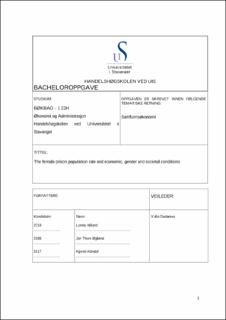| dc.contributor.advisor | Yuila Dudareva | |
| dc.contributor.author | Kjersti Kiledal | |
| dc.contributor.author | Lenita Håland | |
| dc.contributor.author | Jon Thore Øglænd | |
| dc.date.accessioned | 2023-06-27T15:52:50Z | |
| dc.date.available | 2023-06-27T15:52:50Z | |
| dc.date.issued | 2023 | |
| dc.identifier | no.uis:inspera:145995936:70249850 | |
| dc.identifier.uri | https://hdl.handle.net/11250/3073649 | |
| dc.description.abstract | Abstract
Women in prisonis a topic that has received increasing attention in academia in recent years.Whilewomenarea minorityin the total prison population,the rate of women prisoners isrising and has been for many years. Earlier research shows an increase of female prison admissionsin countrieswhere womenhave a higher advancementin economic, societal and equalityconditions.There is also research showing that womenliving in poverty has an increased chance of participating in criminal activities and ending up in prison.
In our thesis we will explore the relationship between economic, gender and societalvariables and the female prisonpopulation rate ofthe total prison population.Whichhave culminatedinto our Problem statement:
Does the female prison ratecorrelate withseveral indexes and topics when it comes to femaleadvancements in regard to economy, genderand societal conditions?
To answer our problem statement,we haveused singleand multiple linear regression, to analyseour dataset.When answering all our research questionsandby this answering our problem statement.
We have reacheda conclusionthat there isa relationship between ourdependent variable the female prison population rate and the different topicsandindexes in our independentvariables. The different relationships are both positive and negativebut with the exception of the Gini index (not significant) and the women’slegal rights (couldnot reject the null hypothesis) they all support our assumptionthat when economic, gender and societal conditions improve for females they will constitute a larger part of the prison population. | |
| dc.description.abstract | Abstract
Women in prisonis a topic that has received increasing attention in academia in recent years.Whilewomenarea minorityin the total prison population,the rate of women prisoners isrising and has been for many years. Earlier research shows an increase of female prison admissionsin countrieswhere womenhave a higher advancementin economic, societal and equalityconditions.There is also research showing that womenliving in poverty has an increased chance of participating in criminal activities and ending up in prison.
In our thesis we will explore the relationship between economic, gender and societalvariables and the female prisonpopulation rate ofthe total prison population.Whichhave culminatedinto our Problem statement:
Does the female prison ratecorrelate withseveral indexes and topics when it comes to femaleadvancements in regard to economy, genderand societal conditions?
To answer our problem statement,we haveused singleand multiple linear regression, to analyseour dataset.When answering all our research questionsandby this answering our problem statement.
We have reacheda conclusionthat there isa relationship between ourdependent variable the female prison population rate and the different topicsandindexes in our independentvariables. The different relationships are both positive and negativebut with the exception of the Gini index (not significant) and the women’slegal rights (couldnot reject the null hypothesis) they all support our assumptionthat when economic, gender and societal conditions improve for females they will constitute a larger part of the prison population. | |
| dc.language | eng | |
| dc.publisher | uis | |
| dc.title | The female prison population rate and economic, gender and societal conditions | |
| dc.type | Bachelor thesis | |
